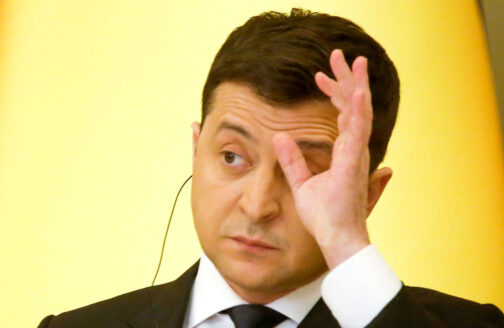Down to the wire

The blow-by-blow of Europeʼs ongoing crisis in Ukraine.
1. The current crisis in Russia-West relations is not primarily about Ukraine, but essentially about the architecture of European security. Russian President Vladimir Putin’s current goal is not to take over Ukraine or wrestle it back to the Russian sphere of influence. Rather, it is to replace the post-Cold War system, which is dominated by the United States and managed through NATO with a construct that rests on two pillars, the US/West and Russia, and is regulated by agreements between the two.
2. Russia has been unhappy about the US politico-military dominance in Europe since at least the mid-late 1990s, when the NATO enlargement process got underway, and NATO interfered in the Kosovo crisis and carried out an air war against Serbia. For a long time, Moscow was powerless to do much about it, and it entertained a hope that, having had to reluctantly accept the inclusion into NATO of Central European, Balkan and even former Soviet Baltic states, it would be able to exercise a sufficient degree of influence to prevent new Eastern European states like Ukraine, Belarus, Moldova and Georgia from going down the same path.
3. Of these countries, Ukraine and Belarus have been historically of vital strategic importance to Russia. Moscow considered their potential loss to the Western alliance intolerable.
4. The Ukrainian Maidan of 2014 dramatically changed the situation in Europe’s east by bringing to power a coalition of pro-Western and anti-Russian elements. To President Putin, even though Russia immediately took control of Crimea and supported anti-Maidan militants in Donbass, this was the biggest strategic loss of his presidency. Since then, preventing Ukraine’s membership in NATO became his last stand in matters of European security.
5. Putin essentially concluded that Western countries, above all the US, only understand the language of force. Moscow doubled down on upgrading its military capabilities. By 2018, Russia had developed an array of new weapons (hypersonic systems and others) that made the Kremlin more confident in dealing with Washington. In Putin’s memorable phrase from his speech to the Russian parliament, but addressed to the Americans, “you did not listen to us before. Listen now.”
6. By early 2021, Putin had lost all expectations – which were revived after Zelensky’s election – that the situation in Donbass and more generally relations with Ukraine could be resolved or managed in a direct dialogue with Kyiv. Worse, in late 2020, suspicions began to circulate in Moscow that Ukraine was planning an attack on Donbass modeled on the successful Azeri operation in Nagorno-Karabakh. To deter the Ukrainians and to send a stern message to Washington, Putin in March-April 2021 ordered the massing of Russian forces along Ukraine’s borders.
7. Russia’s troop demonstration got America’s attention, as Putin must have calculated. US President Joe Biden invited him to a meeting in Geneva in June 2021, where the two leaders agreed to start talks on strategic stability and cyber security, but on the issue of Ukraine there was no movement. Moreover, from the Kremlin’s perspective things began to deteriorate quickly: Kyiv’s clampdown on Russia-friendly political figures and media outlets in Ukraine; more frequent and more daring NATO exercises in the Black Sea area; the testing of Russia’s new maritime borders off Crimea by a UK frigate, and other similar developments.
8. In response, starting in October 2021, President Putin decided to apply military pressure again. The troop concentration on Ukraine’s borders this time was even more impressive. Talking to Russia’s senior diplomats in November 2021, Putin remarked that creating tension in the adversarial camp was helpful to Moscow’s political goals. Again, this worked, up to a point. Presidents Putin and Biden spoke on the phone and had a videoconference. Biden was open to hearing out Russian security concerns. Russian diplomats passed their maximalist proposals/ demands to the US and NATO in the form of draft treaties and a draft agreement. In-depth diplomatic discussion followed between Russia and the US and between Russia and NATO, as well as at the OSCE. US and Russian foreign ministers met. The US and NATO gave written responses to Russian proposals. For the first time since the downfall of the Soviet Union, the US and its allies began actually discussing Russian concerns rather than dismissing them.
9. Yet Vladimir Putin found Western responses wanting. The core Russian demand for Ukraine to be formally excluded forever from NATO membership was predictably rejected, as was the demand of rolling back NATO’s infrastructure to where it was in 1997, when Russia and NATO signed their Founding Act on relations. At the same time, Washington expressed willingness to discuss arms control issues, notably the non-deployment of INF systems in Europe, and abjured any intention of placing strike weapons or forces in a combat role in Ukraine, as well as a range of confidence building measures. In the past, Russia had advocated these measures – a moratorium on INF systems in Europe, a cap on military exercises – but the US had not been interested. Now that has changed.
10. Faced with this mixed bag of US counterproposals (the NATO response was judged in Moscow as politicized and overly ideological), the Kremlin did not immediately use the rejection of its core demands as a pretext for engaging in military measures (read: invasion of Ukraine) or taking military-related steps (read: new permanent deployments of troops and weapons). Instead, Russia continued the dialogue. French President Emmanuel Macron came to Moscow, to be followed by German Chancellor Olaf Scholz. Between those visits, UK foreign and defense secretaries visited Russia. Political directors of the Normandy countries – France, Germany, Russia and Ukraine – met in Paris and Berlin to discuss the implementation of the Minsk agreement on Donbass. Finally, Presidents Putin and Biden spoke again.
11. This intense top-level diplomacy was taking place against the backdrop of Russian military exercises in Belarus and the Black Sea, US troop reinforcements in Europe and White House warnings of an immediate Russian invasion of Ukraine. By mid-February 2022, the war of nerves between Russia and the US reached its culmination.
12. The future is unpredictable, but here are a few conclusions and an analytical outlook:
– Russia has been using its demonstrations of force, which appear as preparation for an invasion, as leverage to get the US to listen to its concerns and act on its demands. This is Putin’s personal diplomatic approach to the US.
– Russia’s demand of NATO’s non-expansion to the former Soviet space cannot be formally met, but there is no chance of Ukraine or Georgia actually making it to NATO as long as Russia regards this as a casus belli.
– The US agreement to negotiate a ban on the deployment of INF systems in Europe is Russia’s gain – in the recent past, Moscow’s proposal of a moratorium was ignored. It makes sense for the US too, as Russia possesses systems (e.g., the Zircon missile) that can be deployed on board submarines patrolling the US coastline and create a similar threat to critical US assets.
– Washington’s openness to inspections of its BMD sites in Romania and Poland (and reciprocal inspections of Russian sites) takes care of another Moscow concern – as it addresses US apprehension with regard to some Russian cruise missiles.
– The willingness of the US to discuss the non-stationing in Ukraine of strike weapons or forces in a combat capacity is another potential win for Moscow.
– Talks with the US and allies on confidence-building measures (limiting the scale and scope of military exercises and the like) would be useful, though clearly of secondary importance.
– On Ukraine, by contrast, there has been no real progress. Kyiv cannot implement the terms of Minsk – such as constitutional autonomy, amnesty and regional elections before regaining control of the region – against the opposition of Ukrainian nationalists who regard Minsk as high treason; the US support for Minsk is half-hearted while German/French influence in Kyiv is insufficient.
– A massive unprovoked Russian invasion will remain a threat and can be effective as long as it is a threat. Actually invading would not be in Russia’s or Putin’s own interest.
– Once the peak of the crisis has passed, one should expect tensions to subside somewhat but remain at a fairly high level for the coming weeks and months.
– Resolution of the current crisis can only be achieved as a result of an agreement on Donbass, along the lines of Minsk, and on Ukraine, along the lines of some kind of a non-bloc status that is appropriately fixed in some form. Neither looks likely in the near or even medium-term future.




